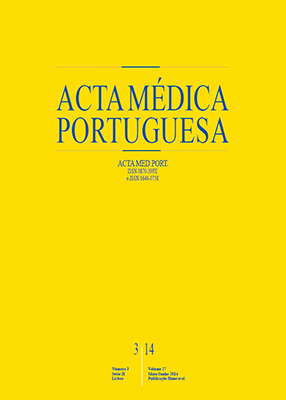Traumatic Brain Injury in Portugal: Trends in Hospital Admissions from 2000 to 2010
DOI:
https://doi.org/10.20344/amp.4892Abstract
Introduction: Traumatic brain injury has a considerable socio-economic impact, being a major cause of morbi-mortality, often with permanent disability. We sought to characterize health resource utilization of adult traumatic brain injury patients in Portugal between 2000 and 2010.
Material and Methods: Retrospective study of medical records of adult patients with ICD9 diagnostic code of traumatic brain injury included in the National Diagnosis Related Groups Database from 2000–2010. Descriptive statistical analysis was performed and trends during the decade were evaluated.
Results: We analysed 72 865 admissions to 111 hospitals, 64.1% males, mean age 57.9 ± 21.8 years (18-107). We found a decrease in number of traumatic brain injury in younger patients and an increase in older ones. The number of traffic accidents decreased and the number of falls increased. There was an increase of moderate to severe traumatic brain injury admissions: 47.2% in 2000 / 80% in 2010. Patients admitted in Intensive Care have nearly doubled (15.8% vs 29.5%) as well as the number submitted to neurosurgical procedures (8.2% vs 15.2%). Total mortality increased from 7.1% to 10.6%.
Discussion: The decrease of traumatic brain injury may be associated with the trauma prevention campaigns, road network improvement and health politics. The increase in mortality may be related to better pre-hospital care, enabling more severe cases to arrive in hospital alive, and although treated more frequently in Intensive Care and requiring more neurosurgical procedures, they end up having higher mortality. Also this may be due to an increase in patients’ age and worse pre-morbid status.
Conclusion: Traumatic brain injury in Portugal is changing. Although hospital admissions due to global traumatic brain injury have decreased, mortality rate has increased.
Keywords: Intensive Care Units; Brain Injuries; Hospitalization; Portugal.
Downloads
Downloads
Published
How to Cite
Issue
Section
License
All the articles published in the AMP are open access and comply with the requirements of funding agencies or academic institutions. The AMP is governed by the terms of the Creative Commons ‘Attribution – Non-Commercial Use - (CC-BY-NC)’ license, regarding the use by third parties.
It is the author’s responsibility to obtain approval for the reproduction of figures, tables, etc. from other publications.
Upon acceptance of an article for publication, the authors will be asked to complete the ICMJE “Copyright Liability and Copyright Sharing Statement “(http://www.actamedicaportuguesa.com/info/AMP-NormasPublicacao.pdf) and the “Declaration of Potential Conflicts of Interest” (http:// www.icmje.org/conflicts-of-interest). An e-mail will be sent to the corresponding author to acknowledge receipt of the manuscript.
After publication, the authors are authorised to make their articles available in repositories of their institutions of origin, as long as they always mention where they were published and according to the Creative Commons license.









